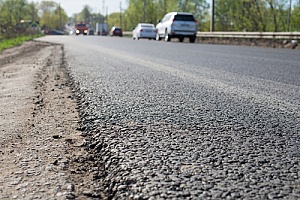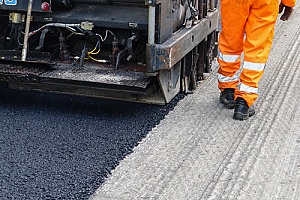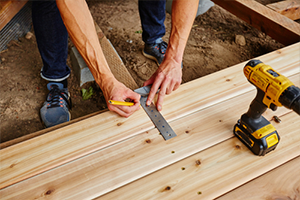 Asphalt millings are made from old asphalt. The old asphalt is taken up and ground into gravel. It is usually spread on a road surface or driveway, and then compacted. Once compacted, the recycled millings will form a surface almost as solid as paving with hot asphalt mix.
Asphalt millings are made from old asphalt. The old asphalt is taken up and ground into gravel. It is usually spread on a road surface or driveway, and then compacted. Once compacted, the recycled millings will form a surface almost as solid as paving with hot asphalt mix.
They have become a popular cost-saving way to pave driveways and parking lots.
The Asphalt Milling Paving Process
Before laying the asphalt millings, the site needs to be properly prepared. Like any other site preparation, the success of the project begins with ensuring adequate water drainage by excavating and grading.
Asphalt Milling Installation
To install asphalt millings properly, your contractor should use power paving machinery. The equipment consists of a paver and a vibratory roller. With this equipment, the asphalt milling pavement will remain more uniform and smoother than it would if you try to shortcut the process or do a DIY installation with a tractor or dozer.
Asphalt Milling Compaction
Once it has been compacted and rolled, the contractor will spray it with a liquid asphalt material that will help the asphalt millings harden and hold together. It will form a surface that is almost as solid as fresh asphalt. It will continue to settle with the heat from the sun. The sun’s heat will melt the asphalt pieces to form a solid surface that will give you the rustic, rural look of gravel but produce less dust.
Benefits of Using Asphalt Millings
Holds Up Better Than Gravel in Wet Conditions
 Recycled asphalt is less susceptible to the elements than traditional gravel material and generates less dust and mud. Gravel is not a stable material for driveways or roads. Over time, the traffic causes the gravel to spread out of its bed, and sink into the subsurface. Before you know it, you are driving on the dirt underneath it. You will have to replace it and regrade it periodically to maintain its integrity. For that reason, some people opt to use crusher run for a driveway, so the dust helps to pack the gravel and hold it together. However, crusher run surface will produce mud in wet weather conditions and low spots will erode and sink. Depending on the crusher run material, it may become sandy, and lose its compaction.
Recycled asphalt is less susceptible to the elements than traditional gravel material and generates less dust and mud. Gravel is not a stable material for driveways or roads. Over time, the traffic causes the gravel to spread out of its bed, and sink into the subsurface. Before you know it, you are driving on the dirt underneath it. You will have to replace it and regrade it periodically to maintain its integrity. For that reason, some people opt to use crusher run for a driveway, so the dust helps to pack the gravel and hold it together. However, crusher run surface will produce mud in wet weather conditions and low spots will erode and sink. Depending on the crusher run material, it may become sandy, and lose its compaction.
Another type of gravel that can be used for roads and driveways is synthetic gravel, sometimes called processed gravel. This product tends to be more expensive than asphalt millings but it will not withstand wet weather as well as millings. Processed gravel usually has clay in it that causes the gravel surface to become soft and messy in wet weather conditions.
Asphalt millings are much more stable in wet weather because it creates a hard surface that will not deteriorate under heavy rain and snow unlike gravel. Also, a road or driveway made of asphalt millings holds up better when it is snow plowed.
Good Base for a Paved Surface
You can also use millings as a good base for later paving with hot-mix asphalt or tar and chip.
Budget Friendly
Asphalt millings are simply recycled asphalt pavement. It is very inexpensive to use as compared with hot-mix asphalt because no new materials need to be manufactured and transported. The initial installation, when done properly, can be costly due to the need for heavy equipment. However, it is much cheaper in the long run due to its low maintenance and durability.
Sustainability Credit Eligible
Consider using asphalt millings if you are working on a LEED project, or concerned about the project’s sustainability. Asphalt millings are an eco-friendly material because they are recycled and long lasting. Using these millings can help you earn LEED credits toward your LEED certification. In certain commercial projects, you may even be eligible for tax credits by using millings. Tax credits could lower your overall effective cost.
 One environmental concern with using gravel is the amount of dust it creates. Researchers at the University of Wyoming wanted to address the problem that the dust created by gravel causes damage to structural integrity, complications with air quality, and health problems as a result. They determined that asphalt millings are the largest single recycling practice in the United States. They also found that gravel or loose roads without recycled asphalt created 147% more dust than those with recycled asphalt. It is indeed an eco-friendly way to pave a road, driveway, parking lot, or path.
One environmental concern with using gravel is the amount of dust it creates. Researchers at the University of Wyoming wanted to address the problem that the dust created by gravel causes damage to structural integrity, complications with air quality, and health problems as a result. They determined that asphalt millings are the largest single recycling practice in the United States. They also found that gravel or loose roads without recycled asphalt created 147% more dust than those with recycled asphalt. It is indeed an eco-friendly way to pave a road, driveway, parking lot, or path.
Low Maintenance
Unlike gravel, which must be regraded and replenished periodically, or hot asphalt which needs to be sealed and patched, asphalt millings need no refinishing, resurfacing, or replacing. It actually gets stronger and harder over time, instead of breaking down like hot asphalt tends to do.
Long Lasting
With normal traffic and wear and tear, a surface made of asphalt millings can last twenty to thirty years, with very little maintenance.
Things to Look Out For With Asphalt Millings
You can find inferior millings made from inferior hot mix asphalt. It will not perform as well as better quality materials.
Some companies have found a way to rejuvenate and re-bond old millings to create a smooth, non-tracking and non-erodible surface. They will use a proprietary blend of acid, polymers and other ingredients that, when incorporated into the millings, will rejuvenate the old asphalt and add a renewed tackiness to the millings. This process allows the millings to re-bond the aggregate to the asphalt in the millings, thus creating a durable surface that repels moisture and stays in place very well once compacted.
Contact the Experts at Dirt Connections for More Information
If you are thinking of using millings for your project, consult with the professionals at Dirt Connections first. They can help you find the best quality millings for your project and provide their expert advice on the amount you will need, costs, and how to prepare the site for delivery. Speak with Dirt Connections for more information about asphalt millings and to schedule a delivery.














































